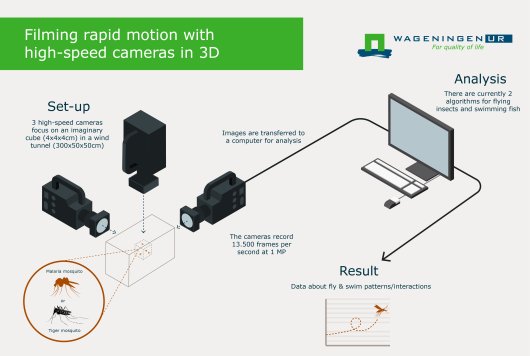Description
High-speed stereoscopic videography system consisting of three high-speed video cameras and dedicated objectives and control equipment.
High-speed videography enables scientists and engineers to study natural and technological phenomena that take place during a fraction of a second. High-speed cameras can record high-resolution digital images at high frame rates and short exposure times (less than a microsecond). Short exposure times reduce motion blur from fast moving objects. By replaying a high-speed video at super slow-motion, researchers can see, understand and analyse the motion of fast moving objects. By filming a study object with multiple synchronized high-speed cameras in a stereoscopic setup, three-dimensional shapes and movements can be reconstructed. Examples of uses of this system within physics and biology are: capturing the motion of an insect wing during flight, capturing the explosive release of plant seeds for seed dispersal, and for studying the impact of a fluid droplet on surfaces.

Technical Details
Details of the set-up
The high-speed videography setup consists the following equipment:
- Three Photron Fastcam SA-X2 cameras
- Three Nikkor AF 200 mm f/4.0D IF-ED Micro objectives (lenses)
- A notebook with camera control software (Photron Fastcam Viewer)
- Cameras synchronization equipment
- The high-speed cameras can be synchronized with each other at an accuracy of 315 nanoseconds. Alternatively, the camera can also be fully synchronised with an external event using a I/O compound cable.
Details of the cameras
- The Photron Fastcam SA-X2 is equipped with a 1024x1024 pixel monochrome CMOS sensor with 20 µm square pixels. The sensor is rated at ISO 25,000 (ISO 12232 Ssat).
- The global electronic shutter can be set between 1ms to 293ns independent of frame rate.
- A build-in automatic mechanical shutter can be used for sensor black balance calibration.
- The cameras can be used with both Nikon photography lenses (Nikon F-mount, G-type compatible) and C-mount lenses.
- A high-speed dual gigabit ethernet interface is used to remote control the camera via the intuitive Photron Fastcam Viewer software and fast image download to a computer or notebook.
- Different trigger modes are possible; e.g. Start, End, Centre, Manual, Time Lapse or Image Trigger based on grey-level changes or background subtraction.
Camera performance
The Photron Fastcam SA-X2 can capture high quality 12-bit megapixel images up to 13,500 frames per second (fps). At a reduced resolution the camera is capable of 1,000,000 fps. They have an internal memory of 32 GB in a 12-bit recording mode at full resolution this provides 21,839 frames. The region of interest can be set by the user in steps of 128 (horizontal) x 8 pixels (vertical).
Examples of frame rate performance and recording duration:
- 12,500 fps at 1024x1024 pixel resolution; 1.74 seconds;
- 13,500 fps at 1024x1000 pixel resolution; 1.65 seconds;
- 40,000 fps at 640x488 pixel resolution; 1.83 seconds;
- 100,000 fps at 384x264 pixel resolution; 2.25 seconds;
- 1,000,000 fps at 128x8 pixel resolution; 22.36 seconds;
In 8-bit recoding mode the recording duration is approximately 1.5 times longer.
Applications
The Photron Fastcam SA-X2 cameras can be used in different research projects that have demands on high frame rate, short exposure times, high image resolution, high dynamic range and high light sensitivity. The motion of fast moving objects can be captured, but also collisions between objects or formation and propagation of cracks at surfaces can be studied using this system.
For more information about the Photron Fastcam SA-X2, visit the Photron website.
Complementary Techniques
The High-speed cameras (3D set-up) stereoscopic videography system consisting of three high-speed video cameras can be used in combination with the High-Speed Intensified Imaging System facility from Wageningen University & Research, Shared Research Facilities:
The high-speed intensified imaging system gives researchers the opportunity to study phenomena in nature that are highly dynamic, like flames, or to study processes that emit light at low intensity, like fluorescent emission in life organisms.